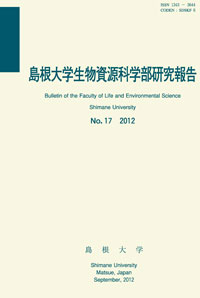島根大学生物資源科学部
ISSN:2435-0885(オンライン)
ISSN:1343-3644(冊子体)
なお、冊子体の刊行は23巻まで
ISSN:1343-3644(冊子体)
なお、冊子体の刊行は23巻まで

ダウンロード数 : ? 件
この文献の参照には次のURLをご利用ください : https://ir.lib.shimane-u.ac.jp/3563
島根大学生物資源科学部研究報告 1
1996-12-20 発行
Subtypes of β-adrenoceptos in the melanophore of Oryzias latipes (Teleostei)
片山 平三郎
永井 一成
Morishita, Fumihiro
ファイル
内容記述(抄録等)
β-Adrenergic agonists, viz, isoprenaline, noradrenaline, adrenaline, dobutamine, salbutamol and terbutaline each in the presence of melatonin and phenoxybenzamine caused the dispersion of pigment within melanophores in which pigment had been made to aggregate by melatonin in isolated scales of Oryzias latipes (a fresh-water teleost). The extent of the dispersion of pigment in the melanophores increased as the external concentration of a β-adrenergic agonist was increased. Assuming that different two types of β-receptors coexist in the melanophores, Hofstee plots for the effects of the β-agonists on the melanophores were analysed with the results that the mean ratio of the percentages of β_1- and β_2-adrenoceptors for the total population of β-receptors was 37.4% : 62.6%, respectively. β-adrenoceptors of the melanophores of Oryzias latipes were confirmed to be β_2-type. The possibility for the occurrence of negative cooperative interactions among β-adrenoceptors in the melanophores was discussed.
About This Article
Other Article
